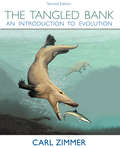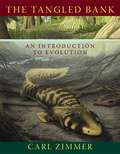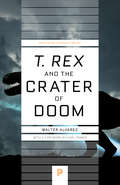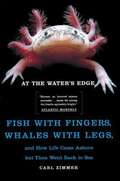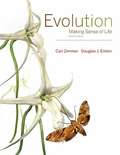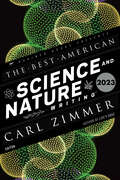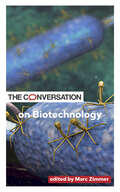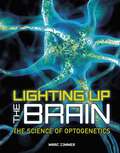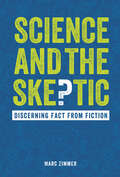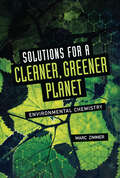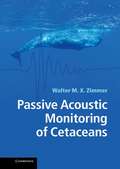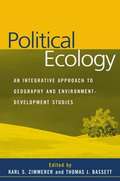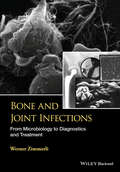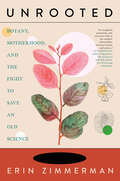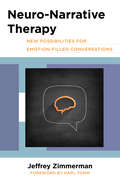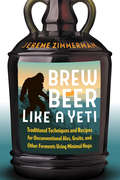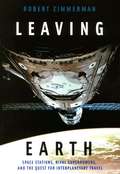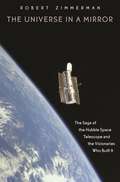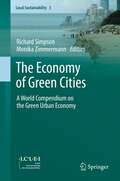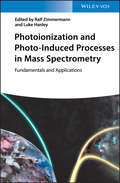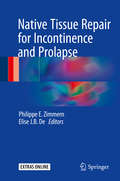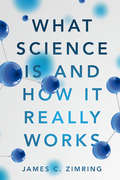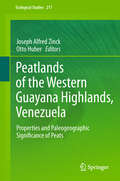- Table View
- List View
The Tangled Bank: An Introduction To Evolution
by Carl ZimmerUsed widely in non-majors biology classes, The Tangled Bank is the first textbook about evolution intended for the general reader. Zimmer, an award-winning science writer, takes readers on a fascinating journey into the latest discoveries about evolution. In the Canadian Arctic, paleontologists unearth fossils documenting the move of our ancestors from sea to land. In the outback of Australia, a zoologist tracks some of the world’s deadliest snakes to decipher the 100-million-year evolution of venom molecules. In Africa, geneticists are gathering DNA to probe the origin of our species. In clear, non-technical language, Zimmer explains the central concepts essential for understanding new advances in evolution, including natural selection, genetic drift, and sexual selection. He demonstrates how vital evolution is to all branches of modern biology—from the fight against deadly antibiotic-resistant bacteria to the analysis of the human genome.
The Tangled Bank: An Introduction to Evolution
by Carl ZimmerThe Tangled Bank is essential reading for anyone who wants to understand the history of life on Earth. This textbook about evolution explains the central concepts essential for understanding new advances in evolution, including natural selection, genetic drift, and sexual selection and demonstrates how vital evolution is to all branches of modern biology-from the fight against deadly antibiotic-resistant bacteria to the analysis of the human genome.
"T. rex" and the Crater of Doom
by Carl Zimmer Walter AlvarezSixty-five million years ago, a comet or asteroid larger than Mount Everest slammed into the Earth, inducing an explosion equivalent to the detonation of a hundred million hydrogen bombs. Vaporized detritus blasted through the atmosphere upon impact, falling back to Earth around the globe. Disastrous environmental consequences ensued: a giant tsunami, continent-scale wildfires, darkness, and cold, followed by sweltering greenhouse heat. When conditions returned to normal, half the plant and animal genera on Earth had perished.This horrific chain of events is now widely accepted as the solution to a great scientific mystery: what caused the extinction of the dinosaurs? Walter Alvarez, one of the Berkeley scientists who discovered evidence of the impact, tells the story behind the development of the initially controversial theory. It is a saga of high adventure in remote locations, of arduous data collection and intellectual struggle, of long periods of frustration ended by sudden breakthroughs, of friendships made and lost, and of the exhilaration of discovery that forever altered our understanding of Earth's geological history.
At The Water's Edge: Fish With Fingers, Whales With Legs, and How Life Came Ashore But Then Went Back To Sea
by Carl Zimmer Carl Dennis BuellEverybody Out of the Pond: At the Water's Edge will change the way you think about your place in the world. The awesome journey of life's transformation from the first microbes 4 billion years ago to Homo sapiens today is an epic that we are only now beginning to grasp. Magnificent and bizarre, it is the story of how we got here, what we left behind, and what we brought with us. We all know about evolution, but it still seems absurd that our ancestors were fish. Darwin's idea of natural selection was the key to solving generation-to-generation evolution -- microevolution -- but it could only point us toward a complete explanation, still to come, of the engines of macroevolution, the transformation of body shapes across millions of years. Now, drawing on the latest fossil discoveries and breakthrough scientific analysis, Carl Zimmer reveals how macroevolution works. Escorting us along the trail of discovery up to the current dramatic research in paleontology, ecology, genetics, and embryology, Zimmer shows how scientists today are unveiling the secrets of life that biologists struggled with two centuries ago. In this book, you will find a dazzling, brash literary talent and a rigorous scientific sensibility gracefully brought together. Carl Zimmer provides a comprehensive, lucid, and authoritative answer to the mystery of how nature actually made itself.
Evolution: Making Sense of Life
by Carl Zimmer Douglas Emlen<p>Science writer Carl Zimmer and evolutionary biologist Douglas Emlen have produced a thoroughly revised new edition of their widely praised evolution textbook. Emlen, an award-winning evolutionary biologist at the University of Montana, has infused Evolution: Making Sense of Life with the technical rigor and conceptual depth that today’s biology majors require. Zimmer, an award-winning New York Times columnist, brings compelling storytelling to the book, bringing evolutionary research to life. <p>Students will learn the fundamental concepts of evolutionary theory, such as natural selection, genetic drift, phylogeny, and coevolution. The book also drives home the relevance of evolution for disciplines ranging from conservation biology to medicine. With riveting stories about evolutionary biologists at work everywhere from the Arctic to tropical rainforests to hospital wards, the book is a reading adventure designed to grab the imagination of students, showing them exactly why it is that evolution makes such brilliant sense of life.</p>
The Best American Science and Nature Writing 2023 (Best American)
by Carl Zimmer Jaime GreenThe Best American Science and Nature Writing 2023 has descriptive copy which is not yet available from the Publisher.
The Conversation on Biotechnology (Critical Conversations)
by Marc ZimmerFrom the contributors to The Conversation, this collection of essays by leading experts in biotechnology provides foundational knowledge on a range of topics, from CRISPR gene sequencing to the ethics of GMOs and "designer babies."In The Conversation on Biotechnology, editor Marc Zimmer collects essays from The Conversation U.S. by top scholars and experts in the field, who present a primer on the latest biotechnology research, the overwhelming possibilities it offers, and the risks of its abuse. From an overview of CRISPR technology and gene editing in GMOs to the ethical questions surrounding "designer babies" and other applications of biotechnology in humans, it highlights the major implications biotechnology will bring for health and society. Topics range from the spectacular use of light to fire individual neurons in the brain to making plant-based meats; from curbing diseases with genetically modified mosquitoes to looking back on 40 years of opinions on IVF babies.The Critical Conversations series collects essays from top scholars on timely topics, including water, biotechnology, gender diversity, gun culture, and more, originally published on the independent news site The Conversation U.S.Contributors: Nathan Ahlgren, Ivan Anishchenko, Trine Antonsen, Jennifer Barfield, Pedro Belda-Ferre, Ari Berkowitz, Adeline Boettcher, Jason Delbourne, Kevin Doxzen, Mo Ebrahimkhani, Eleanor Feingold, J. Benjamin Hurlbut, Cecile Janssens, Samira Kiani, Amanda Kowalczyk, Mariana Lamas, Andrew Lapworth, Rebecca Mackelprang, Kathleen Merrigan, Saman Naghieh, Sean Nee, Dimitri Perrin, Christopher Preston, Jason Rasgon, Penny Riggs, Jason Robert, Oliver Rogoyski, Gary Samore, Sahotra Sarkar, George E. Seidel, Patricia A. Stapleton, Craig W. Stevens, Paul B. Thompson, Christopher Tuggle, Vikramaditya G. Yadav, Marc Zimmer
Lighting Up the Brain: The Science of Optogenetics
by Marc ZimmerWhat if neuroscientists could look inside the human brain and watch individual brain cells send signals to one another? What if they could then control these brain cells to direct thoughts and actions? This may sound like science fiction, but it's actually a scientific revolution called optogenetics. Neuroscientists would like to use this new technology on human brains to uncover secrets about how the brain processes information and drives human behavior. Doctors hope to use optogenetics to restore sight and to treat Alzheimer's disease, Parkinson's disease, depression, and other debilitating or deadly health problems. Discover how the innovative work of leaders in the field is poised to radically transform science, medicine, and human health.
Science and the Skeptic: Discerning Fact from Fiction
by Marc ZimmerFake news, pseudoscience, and quackery have become scourges, spreading through society from social media all the way to Congress. The line between entertainment and reality, between fact and fiction, has become blurred. Some of the most crucial issues of our time—climate change, vaccines, and genetically modified organisms—have become prime targets for nefarious disinformation campaigns. Far too many people have become distrustful of real science. Even those who still trust science no longer know what to believe or how to identify the truth. Not only does this result in the devaluation and distrust of real science, but it is also dangerous: people acting based on false information can hurt themselves or those around them. We must equip ourselves with the knowledge and skills to fight back against all this disinformation. InScience and the Skeptic: Discerning Fact from Fiction, you will learn how science is done, from the basic scientific method to the vetting process that scientific papers must go through to become published; how and why some people intentionally or unintentionally spread misinformation; and the dangers in believing and spreading false information. You'll also find twenty easy-to-follow rules for distinguishing fake science from the real deal. Armed with this book, empower yourself with knowledge, learning what information to trust and what to dismiss as deceit. "We're not just fighting an epidemic; we're fighting an infodemic. . . . This is a time for facts, not fear. This is a time for rationality, not rumors. This is a time for solidarity, not stigma."—Tedros Adhanom Ghebreyesus, director-general of the WHO "Our deepest beliefs should help navigate reality, not determine it."—Michael Gersen, The Washington Post "Journalism is very much about trying to simplify and distribute information about what's new and where advances have been made. That's incompatible with the scientific process, which can take a long time to build a body of evidence."—Kelly McBride, Poynter Institute
Solutions for a Cleaner, Greener Planet: Environmental Chemistry
by Marc ZimmerMany of the most toxic materials on Earth—from arsenic to plutonium—occur naturally, but manufacturers have also used them in products such as paints, plumbing, pesticides, nuclear fuel, and weaponry. Without careful management, toxins can leach into groundwater or pollute our environment. Exposure to toxins leads to various cancers, impairment of the immune and reproductive systems, as well as cognitive problems. What can be done? Solutions include a wide range of infrastructure approaches, such as better water filtration, governmental and manufacturing regulations, outright bans on certain chemicals, careful monitoring, and the use of alternative fuels. Learn more about key contaminants and their impact on health, as well as solutions on a global and individual level.
Passive Acoustic Monitoring of Cetaceans
by Walter ZimmerPassive acoustic monitoring is increasingly used by the scientific community to study, survey and census marine mammals, especially cetaceans, many of which are easier to hear than to see. PAM is also used to support efforts to mitigate potential negative effects of human activities such as ship traffic, military and civilian sonar and offshore exploration. Walter Zimmer provides an integrated approach to PAM, combining physical principles, discussion of technical tools and application-oriented concepts of operations. Additionally, relevant information and tools necessary to assess existing and future PAM systems are presented, with Matlab code used to generate figures and results so readers can reproduce data and modify code to analyse the impact of changes. This allows the principles to be studied whilst discovering potential difficulties and side effects. Aimed at graduate students and researchers, the book provides all information and tools necessary to gain a comprehensive understanding of this interdisciplinary subject.
Political Ecology
by Karl Zimmerer Thomas J. BassettThis volume offers a unique, integrative perspective on the political and ecological processes shaping landscapes and resource use across the global North and South. Twelve carefully selected case studies demonstrate how contemporary geographical theories and methods can contribute to understanding key environment-and-development issues and working toward effective policies. Topics addressed include water and biodiversity resources, urban and national resource planning, scientific concepts of resource management, and ideas of nature and conservation in the context of globalization. Giving particular attention to evolving conceptions of nature-society interaction and geographical scale, an introduction and conclusion by the editors provide a clear analytical focus for the volume and summarize important developments and debates in the field.
Bone and Joint Infections
by W. ZimmerliBone and Joint Infections is the first book to take a multidisciplinary approach to covering the causes and treatment of osteomyelitis and septic arthritis. Correct and rapid diagnosis of bone and joint infection requires the input of a variety of specialists, and Bone and Joint Infection takes a similarly collaborative and comprehensive approach, including chapters from a diverse group of clinicians, researchers, and surgeons.Covering both the basic microbiology and clinical aspects of bone and joint infection, this book will be a valuable resource both for researchers in the lab and for physicians and surgeons seeking a comprehensive reference on osteomyelitis and septic arthritis.
Unrooted: Botany, Motherhood, and the Fight to Save an Old Science
by Erin Zimmerman"Evolutionary botanist Zimmerman discusses her passion for plants and inveighs against sexism in the sciences in her marvelous debut memoir...Throughout, Zimmerman&’s enthusiasm and expertise make the science accessible even to those without a background in the subject. The results are as edifying as they are galvanizing." - Publishers Weekly STARRED Review"Erin Zimmerman has exposed a rooted gender failure in science. Her book is important not for this alone. Her work is essential for understanding the future resilience of all flora on this planet." -Diana Beresford-Kroeger, author of To Speak for the TreesAn exploration of science, motherhood, and academia, and a stirring account of a woman at a personal and professional crossroads . . .Growing up in rural Ontario, Erin Zimmerman became fascinated with plants—an obsession that led to a life in academia as a professional botanist. But as her career choices narrowed in the face of failing institutions and subtle, but ubiquitous, sexism, Zimmerman began to doubt herself.Unrooted: Botany, Motherhood, and the Fight to Save an Old Science is a scientist&’s memoir, a glimpse into the ordinary life of someone in a fascinating field. This is a memoir about plants, about looking at the world with wonder, and about what it means to be a woman in academia—an environment that pushes out mothers and those with any outside responsibilities. Zimmerman delves into her experiences as a new mom, her decision to leave her position in post-graduate research, and how she found a new way to stay in the field she loves.She also explores botany as a &“dying science&” worth fighting for. While still an undergrad, Zimmerman&’s university started the process of closing the Botany Department, a sign of waning funding for her beloved science. Still, she argues for its continuation, not only because we have at least 100,000 plant species yet to be discovered, but because an understanding of botany is crucial in the fight against climate change and biodiversity loss.Zimmerman is also a botanical illustrator and will provide 8 original illustrations for the book.
Neuro-Narrative Therapy: New Possibilities For Emotion-filled Conversations
by Jeffrey ZimmermanBringing interpersonal neurobiology and narrative therapy together. Narrative therapy understands storytelling as the way we make sense of ourselves and life experience. Many non-narrative therapists have expressed great admiration and interests in the politics the work exposes, the way it brings in the socio-political context, and the way it centers clients. Yet despite its popularity and success as a useful therapeutic approach, Narrative Therapy has been criticized as minimizing and failing to develop any extended discussion of something vital to our lives: emotion. Neuro-Narrative Therapy attempts to redress this problem by taking us first through standard Narrative practices, and then showing how and where affect can be brought in and even privileged in the work. After situating the evolution of Narrative Therapy in its historical context, the book provides information about why emotions should be given an important place in the work. Specifically, it brings ideas and implications of some of the most exciting and novel theories—interpersonal neurobiology and affective neuroscience—to the practice of Narrative Therapy. Readers will learn about the growing emphasis on the right brain, and how an understanding of the ways in which emotion and affect are manifested by the brain can help us help our clients. The possibilities for this new approach are many: a freer discussion of the emotional side of your clients; an understanding and sensitivity to the relation of body and mind; attention to how the therapeutic relationship of our clients can become a resource in treatment and a renewed understanding of how our memories—and thus our stories about our lives—develop in early childhood and beyond. For any therapist working in the area of Narrative Therapy, and for any interested in the emerging understandings that science is bringing to appreciating how our brains develop with and among each other, this book has something to offer. Combining the neuro- and the narrative, as Jeffrey Zimmerman has done here, will create a new direction in Narrative Therapy, one in which our brain and body work together, inviting a more direct and effective engagement with clients.
Brew Beer Like a Yeti: Traditional Techniques, Recipes, And Inspiration For Unconventional Ales, Gruits, And More
by Jereme ZimmermanExperimentation, mystery, resourcefulness, and above all, fun--these are the hallmarks of brewing beer like a Yeti. <P><P> Since the craft beer and homebrewing boom of the late twentieth and early twenty-first centuries, beer lovers have enjoyed drinking and brewing a vast array of beer styles. However, most are brewed to accentuate a single ingredient--hops--and few contain the myriad herbs and spices that were standard in beer and gruit recipes from medieval times back to ancient people's discovery that grain could be malted and fermented into beer. <P><P> Like his first book, Make Mead Like a Viking, Jereme Zimmerman's Brew Beer Like a Yeti returns to ancient practices and ingredients and brings storytelling, mysticism, and folklore back to the brewing process, including a broad range of ales, gruits, bragots, and other styles that have undeservingly taken a backseat to the IPA. Recipes inspired by traditions around the globe include sahti, gotlandsdricka, oak bark and mushroom ale, wassail, pawpaw wheat, chicha de muko, and even Neolithic "stone" beers. <P><P> More importantly, under the guidance of "the world's only peace-loving, green-living Appalachian Yeti Viking," readers will learn about the many ways to go beyond the pale ale, utilizing alternatives to standard grains, hops, and commercial yeasts to defy the strictures of style and design their own brews.
Leaving Earth: Space Stations, Rival Superpowers, And The Quest For Interplanetary Travel
by Robert ZimmermanCharged with the ever-present potential for danger and occasionally punctuated by terrible moments of disaster, the history of space exploration has been keenly dramatic. The recent disaster of the Space Shuttle Columbia was a sad but certain reminder that space travel is an extraordinarily dangerous occupation. Oddly enough, it often takes a tragic accident to remind us that we still have a presence in space. In the decades between triumph and tragedy we tend to ignore the fact that there have been scores of space pioneers who have risked their lives to explore our solar system. Indeed, the International Space Station is sometimes referred to as “Alpha,” a moniker that implies that it is our first real permanent presence in space. But this notion is frowned upon by the Russians – and for good reason. Prior to the construction of the controversial International Space Station, a host of daring Russian cosmonauts, and a smaller number of intrepid American astronauts, were living in space for months, some of them for over a year. In this definitive account of man’s quest to become citizens of the cosmos, noted space historian Robert Zimmerman reveals the great global gamesmanship between Russian and American political leaders that drove us to the stars. Beaten to the Moon by their Cold War enemies, the Russians were intent on being first to the planets. They believed that manned space stations held the greatest promise for reaching other worlds and worked feverishly to build a viable space station program – one that would dwarf American efforts and allow the Russians to claim the vast territories of space as their own. Although unthinkable at the time, the ponderously bureaucratic Soviet Union actually managed to overtake the United States in the space station race. Leveraging their propaganda machine and tyrannical politics to launch a series of daring, dangerous, and scientifically brilliant space exploits, their efforts not only put them far ahead of NASA, they also helped to reshape their own society, transforming it from dictatorship to democracy. At the same time, the American space program at NASA was also evolving, but not necessarily for the better. In fact, the two programs were slowly but inexorably trading places. Drawing on his vast store of knowledge about space travel, as well as hundreds of interviews with cosmonauts, astronauts, and scientists, Zimmerman has superbly captured the excitement and suspense of our recent space-traveling past. For space and history enthusiasts alike, Leaving Earth describes a rich heritage of adventure, exploration, research, and discovery.
The Universe in a Mirror: The Saga of the Hubble Space Telescope and the Visionaries Who Built It
by Robert ZimmermanThe Hubble Space Telescope has produced the most stunning images of the cosmos humanity has ever seen. It has transformed our understanding of the universe around us, revealing new information about its age and evolution, the life cycle of stars, and the very existence of black holes, among other startling discoveries. But it took an amazing amount of work and perseverance to get the first space telescope up and running. The Universe in a Mirror tells the story of this telescope and the visionaries responsible for its extraordinary accomplishments. Robert Zimmerman takes readers behind the scenes of one of the most ambitious scientific instruments ever sent into space. After World War II, astronomer Lyman Spitzer and a handful of scientists waged a fifty-year struggle to build the first space telescope capable of seeing beyond Earth's atmospheric veil. Zimmerman shows how many of the telescope's advocates sacrificed careers and family to get it launched, and how others devoted their lives to Hubble only to have their hopes and reputations shattered when its mirror was found to be flawed. This is the story of an idea that would not die--and of the dauntless human spirit. Illustrated with striking color images, The Universe in a Mirror describes the heated battles between scientists and bureaucrats, the perseverance of astronauts to repair and maintain the telescope, and much more. Hubble, and the men and women behind it, opened a rare window onto the universe, dazzling humanity with sights never before seen. This book tells their remarkable story. A new afterword updates the reader on the May 2009 Hubble service mission and looks to the future of astronomy, including the prospect of a new space telescope to replace Hubble.
The Economy of Green Cities: A World Compendium on the Green Urban Economy
by Monika Zimmermann Richard SimpsonThis volume bridges the gap between the global promotion of the Green Economy and the manifestation of this new development strategy at the urban level. Green cities are an imperative solution, not only in meeting global environmental challenges but also in helping to ensure socio-economic prosperity at the local level.
Photoionization and Photo-Induced Processes in Mass Spectrometry: Fundamentals and Applications
by Ralf ZimmermannProvides comprehensive coverage of laser-induced ionization processes for mass spectrometry analysis Drawing on the expertise of the leading academic and industrial research groups involved in the development of photoionization methods for mass spectrometry, this reference for analytical scientists covers both the theory and current applications of photo-induced ionization processes. It places widely used techniques such as MALDI side by side with more specialist approaches such as REMPI and RIMS, and discusses leading edge developments in ultrashort laser pulse desorption, to give readers a complete picture of the state of the technology. Photoionization and Photo-Induced Processes in Mass Spectrometry: Fundamentals and Applications starts with a complete overview of the fundamentals of the technique, covering the basics of the gas phase ionization as well as those of laser desorption and ablation, pulse photoionization, and single particle ionization. Numerous application examples from different analytical fields are described that showcase the power and the wide scope of photo ionization in mass spectrometry. -The first general reference book on photoionization techniques for mass spectrometry -Examines technologies and applications of gas phase resonance-enhanced multiphoton ionization mass spectrometry (REMPI-MS) and gas phase resonance ionization mass spectrometry (RIMS) -Provides complete coverage of popular techniques like MALDI -Discusses the current and potential applications of each technology, focusing on process and environmental analysis Photoionization and Photo-Induced Processes in Mass Spectrometry: Fundamentals and Applications is an excellent book for spectroscopists, analytical chemists, photochemists, physical chemists, and laser specialists.
Der Klimaschutzdiskurs der „Neuen Rechten“: Eine ideengeschichtliche Analyse des Periodikums Die Kehre – Zeitschrift für Naturschutz (BestMasters)
by Wiebke ZimmermannUmwelt- wie auch konkret der Klimaschutz als dessen jüngerer Teilbereich sind weder neutrale Sachthemen noch notwendigerweise politisch links zu verorten. Im historischen Rückblick lassen sich Momente der geglückten wie gescheiterten Verquickung nationalistischer und antidemokratischer Positionen mit „grünen“ Forderungen im gesellschaftspolitischen Diskurs ausmachen. Auch im Lichte des gegenwärtigen Relevanzgewinns der Causa Klimawandel regen sich im neurechten Lager erneut die Versuche einer (Rück-)Eroberung der Diskurshoheit. Paradigmatisch hierfür steht das neurechte Periodikum Die Kehre – Zeitschrift für Naturschutz, das sich als Debattenort zur Etablierung einer „konservativen Ökologie“, der Verbindung von Ökologie mit rechtsideologischen Elementen, ins Werk setzt. Welche Positionen beziehen, welche Begründungzusammenhänge formulieren Akteur*innen der „Neuen Rechten“ zum Klimaschutz? Die vorliegende Arbeit rekonstruiert Amalgamierungsmomente neurechter (Vorläufer-)Gruppierungen mit Themen des Umweltschutzes und systematisiert so die Chronologie der Genese der „Neuen Rechten“ in einem umweltethischen Zusammenhang. Auf diesem Fundament wird eine Tiefenanalyse der klimaschutzpolitischen Argumentationen innerhalb des neurechten Periodikums Die Kehre geleistet, die identifizierten Positionen werden hinsichtlich ihrer inhaltlichen und strukturellen Brücken in neurechte Traditions- und Ideologiebestände kontextualisiert und interpretiert.
Native Tissue Repair for Incontinence and Prolapse
by Philippe E. Zimmern Elise J. B. DeThis book demonstrates knowledge on tissue-based procedures for stress urinary incontinence and other pelvic floor related topics. As the field shifts away from using synthetic material for repair, this work presents a new perspective on native tissue repair from the opinions and research of the authors. Written by a panel of expert authors in the field, this text provides high quality, focused information that is complimented by illustrations and videos. With established track records the authors illustrate how to perform the procedure vaginally or through open surgery, and inclusion of live surgeries via online video, makes this an invaluable tool for busy surgeons and specialists interested in pelvic floor reconstruction.
What Science Is and How It Really Works
by James C. ZimringScientific advances have transformed the world. However, science can sometimes get things wrong, and at times, disastrously so. Understanding the basis for scientific claims and judging how much confidence we should place in them is essential for individual choice, societal debates, and development of public policy and laws. We must ask: what is the basis of scientific claims? How much confidence should we put in them? What is defined as science and what is not? This book synthesizes a working definition of science and its properties, as explained through the eyes of a practicing scientist, by integrating advances from philosophy, psychology, history, sociology, and anthropology into a holistic view. Crucial in our political climate, the book fights the myths of science often portrayed to the public. Written for a general audience, it also enables students to better grasp methodologies and helps professional scientists to articulate what they do and why.
Decarbonization of Maritime Transport (Energy, Environment, and Sustainability)
by Burak Zincir Pravesh Chandra Shukla Avinash Kumar AgarwalThis contributed book focuses on decarbonization of maritime transport by highlighting different aspects of decarbonization methods indicated in the International Maritime Organization’s Initial Greenhouse Gas Strategy (2018). The book contains studies on alternative fuels and alternative energy systems with their life cycle assessment, electrification and hybridization of ships, carbon capture technologies, green port concept, energy efficiency management, and market-based measures. This book will be of interest to those working in academia and industry in maritime technologies and transportation.
Peatlands of the Western Guayana Highlands, Venezuela
by Joseph Alfred Zinck Otto HuberThe Guayana Highlands in northeastern tropical America, rising from lowland rain forests and savannas up to 3000 m elevation, are characterized by ancient tablelands called tepuis. The peatlands that developed on the tepuis constitute unique and fascinating ecosystems and are the focus of this volume, which starts with an overview of tropical and subtropical peats, followed by an introduction to the geo-ecological features of the Guayana region as a whole, with special emphasis on the diversity of the vegetation cover from lowlands to uplands to highlands. The core subject centers on the properties and dating of the peat deposits and the interpretation of the chronological record in terms of past environmental changes. The well illustrated book will appeal to a broad range of scientists interested in tropical highland peats, including quaternarists, soil scientists, geomorphologists, geographers, geologists, ecologists, botanists, hydrologists, conservationists, and land use planners.
